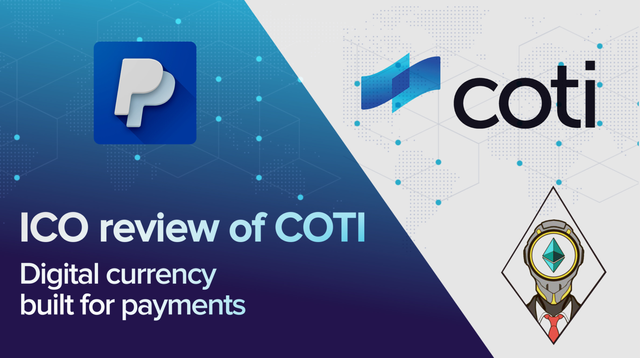AN ANALYSIS OF ICO: COTI

Global payments industry includes many different organizations, intermediaries, clearing houses, Bank processors, gateways, and, of course, merchants and consumers. COTI mechanism aims to become the de facto payment to sellers for doing business in cryptocurrencies (their own, XCT, as well as others) and fiat. The overview document COTI says: "The COTI team was formed to fill this void. COTI combines the best of traditional payment systems with the best digital currencies - with their respective limitations - to provide a comprehensive payment solution that is optimized for the requirements of typical consumers and sellers, first and foremost."
For those of you who are not familiar with the industry payments, there are certain entities involved in payment transactions using traditional payment methods, and brands such as Visa and MasterCard. Let's look at the traditional process; there are the card holder and the consumer as well as seller who wants to accept payment for goods or services and receives a trading account for this. Payment gateway allows credit card payments and provides secure transmission of payment information between the merchant's website or POS machine and merchant account. Payment processor operates to process the credit card transaction from beginning to end. It does this by connecting a trading account to the payment gateway so it can receive data about the transaction, and also connects the gateway to the credit card network for authorization from the issuing Bank. The issuing Bank issues credit cards to consumers. They are responsible for the payment of the Bank-acquirer for purchases made by their owners.
Network of credit cards helps to bind the banks issuing and acquiring, by sending the appropriate transactional information between the two banks. The Bank-acquirer also referred to as commercial Bank, because it creates and maintains trading accounts that allow commercial businesses to accept credit and debit cards. So, if you ever wondered what happens when you take your card, you come. As you can see, in this space there are many opportunities for companies based on blockchain, due to the fact that at the present time involved in the transaction chains of the numerous structures. These chains increase the cost. The question is, how COTI fits into this trillion-dollar industry?
The review article was well written with a detailed description of the applications and services of the organization, including a wallet with an internal exchange and a virtual debit card for consumers, processing tools for merchants, which appear as a virtual gateway and platform for mediators to deal with disputes in its network. Fee structure COTI is based on a trust account derived from the transaction history of that person or the seller.
The company also says:
"In addition to the adoption of measures to combat the manipulation of a trust account, COTI ensures that parties with a low condence score have a clear path to achieving higher levels of confidence. COTI is not going to miss participants with a low trust score on either side and actively encourages members of the network for good steps to increase your points. If a participant with a low rate may prove valuable for the network, showing honest, trustworthy behavior over time, this value will be reflected in his scores ".
Token
The token is a native currency called the XCT; the company did not specify how bloccano they will connect to their internal registration platform. A private digital currency COTI is located in the center of the network COTI and stimulates the interaction between consumers, merchants and intermediaries. XCT was created specifically to overcome the barriers that have limited wide spread of digital currency for everyday payments. All fees incurred during network usage COTI, payable in XCT. The charging of fees denominated in XCT is applied to all transactions regardless of the currency used for the primary payment. Mediation rates and payments are always made in XCT. Thus, intermediaries will have to hold XCT if they want to participate in mediation. XCT functions as a medium of exchange that can be used when making and receiving payments for goods or services.
Team
The core team consists of several people with experience in the payments and technology sector, as well as experience in startups. The company hopes to have a lot more consultants, including those from the banking and payments space for the joint implementation of the project.
Several advisers were also presented in a promotional company video and on-site sales of tokens.
The verdict
Risks
· There is initial doubt about the level of adoption of the main traders - why this option kleptoplasty more advantageous compared to all the others? -1
· Does not mention the target customer segment. -1,5
Growth potential
· Add protection buyers and sellers through intermediaries is an essential aspect in existing the field of digital currency. + 2
· COTI will be able to cope with processing a large number of transactions since the beginning, originally in the amount of 10 000 transactions per second (TPS), and its architecture will be scalable for higher throughput. All transactions will be confirmed instantly +3
· Low or no fees can attract existing dealers with a high level of risk. These include adult entertainment, online pharmacy, merchants, CBD, etc. COTI may be a viable option, but the mention of the target segment was not detected. + 3
· The project aims to be high levels of approval for cross-border e-Commerce transactions. +2
Impression
Based on the above analysis, we get a 6.5 out of 10 points for COTI. The project has the potential. Technology, team and concept looks strong, but also there are moments which should be well weighed before investing their money in this project.
Website: https://coti.io/
Whitepaper: https://coti.io/files/COTI-technical-whitepaper.pdf
Token Economy: https://coti.io/files/COTI-Token-Sale-Summary.pdf